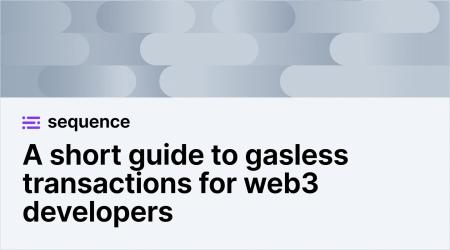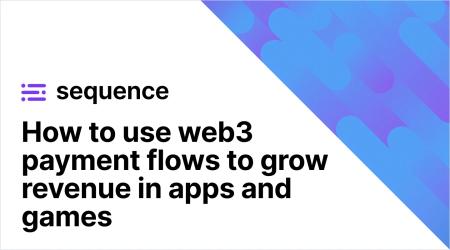9 questions web2 developers ask about web3 (and easy answers)
June 18 2025

As a web2 developer looking to break into decentralized apps, chances are you’ve typed questions like “How do I start with web3?” or “Which smart contract language should I learn?” into search bars or AI tools like ChatGPT.
To help you navigate the noise, we’ve compiled the nine most common questions developers are asking about web3. Sourced from search engines, developer forums, AI tools, and social platforms, each question is paired with a clear, straightforward answer.
Kickstart your journey into web3 development with this quick guide, and don’t hesitate to reach out if you have questions!
1. What is web3?
Web3 refers to a paradigm of the internet that is decentralized, trustless, and user-owned. Unlike web2, where large tech companies control the flow of data, personal information, and services, web3 runs on blockchain technology, which distributes control across a network.
- Users own assets (like NFTs or fungible tokens like crypto) directly via digital wallets (web3 wallets).
- Smart contracts automate trust and logic without intermediaries.
- dapps (decentralized apps, or web3 apps) replace centralized platforms like banks or social media with blockchain-based alternatives.
This decentralized model aims to create more transparency, censorship resistance, and user empowerment.
2. How do I start building dapps (decentralized applications)?
Platforms like Sequence accelerate development across web, mobile, and game engines with powerful SDKs. To build a web3 app, follow these basic steps:
- Choose a blockchain: Ethereum is most common, but many other networks of the Ethereum Virtual Machine (EVM), such as Arbitrum, Polygon, and Avalanche, are popular alternatives.
- Write and deploy smart contracts: Code with Solidity or leverage boilerplates from established web3 development platforms such as Sequence to write, test, and deploy your smart contracts to a testnet (e.g. Goerli, Sepolia).
- Build the frontend: Use frameworks like Next.js, React, or libraries like Sequence.js, Ethers.js, and Web3.js to connect to your smart contract.
- Add wallet integration: Use Sequence smart wallet solutions to create and manage login processes familiar to users (email, social etc.).
3. Which programming languages are essential for web3 development?
Popular coding languages in web3 include:
- Solidity: The primary language for smart contracts on EVM chains (such as Ethereum, Arbitrum, Polygon, Optimism, etc.).
- Rust: Used on Solana, Polkadot, NEAR.
- Move: Used on newer chains like Aptos and Sui.
- JavaScript/TypeScript: Still essential for building web3 frontends. Libraries like web3.js, ethers.js, sequence.js, and wagmi power dapp interactions.
4. What's the easiest way to deploy smart contracts?
Smart contracts are pieces of code that run on the blockchain. Here’s a quick summary on how to deploy a smart contract:
Option 1: For full control Use Hardhat or Foundry to:
- Write a contract (e.g., MyToken.sol)
- Compile and test it
- Deploy to testnet/mainnet via scripts
Option 2: For speed and templates Use Sequence boilerplates to:
- Choose a pre-built contract (e.g., ERC-20 or NFT Drop)
- Customize parameters (name, supply, price)
- Deploy with no code via the interface or SDK
Sequence’s web3 platform lets you manage smart contracts through an intuitive visual interface and seamlessly integrate them into your frontend.
5. What are the biggest smart contract security risks?
Exploits cost millions, security is a top priority for developers building in web3. Common vulnerabilities include:
- Reentrancy attacks: A contract calls another contract, which calls back before finishing execution. Prevent with mutexes or checks-effects-interactions pattern.
- Integer overflows/underflows: Arithmetic errors that change balances unintentionally. Use SafeMath or modern Solidity versions.
- Front-running: Attackers see a transaction in the mempool and race to get theirs processed first. Consider using commit-reveal schemes.
- Insecure external calls: Always validate return values and use call with caution.
You can secure your code with:
- Audits (internal + external)
- OpenZeppelin contracts
- Bug bounty programs
6. How do I integrate wallet authentication into my app?
Seamless login is critical to enable seamless user onboarding for non-crypto-native audiences. There are two main approaches:
“Traditional” web3 login
- Use MetaMask or WalletConnect
- The user signs a message to prove ownership of a wallet (no email/password)
- More cumbersome due to pop-ups, downloads, or seed phrases
Web2-friendly onboarding
- Use Sequence smart wallet solutions
- Enable sign-in with Google, Apple, email, or social logins (e.g. Facebook, Twitch, Epic, Playfab, Stytch)
- Customize the UI to match your brand (optional)
- Behind the scenes, users still get non-custodial wallets
The web2-friendly onboarding approach is a hybrid model that lowers the barrier for non-crypto-savvy users while keeping decentralization benefits in place.
7. What is tokenomics, and how does it affect my project?
A well-designed token drives usage, governance, and growth. Tokenomics refers to how you structure and use tokens within your ecosystem. It includes:
- Supply: Fixed or inflationary? How much is in circulation?
- Utility: What can the token do: governance, payments, access, staking, other?
- Incentives: How are users, developers, and investors rewarded or retained?
- Distribution: How is the token allocated (team, investors, community, treasury)?
Good tokenomics aligns user behavior with project goals. Bad tokenomics can lead to volatility and app abandonment.
8. How do oracles, intent-based protocols and cross-chain tools work?
Developers may need to bring real-world data or connect multiple chains. They can do so via:
Oracles (like Chainlink, Band Protocol) allow smart contracts to access off-chain data, like prices, weather, or sports scores. For example, a dapp on Ethereum should use an oracle if it wants to use price data from an external exchange. Without oracles, smart contracts can’t interact with the real world. Example:
- An off-chain service fetches data (from an API, website, etc.)
- The data is signed and sent onchain by the oracle provider
- Your smart contract reads the oracle’s data and executes logic based on it
Cross-chain bridges/tools (like Axelar, Wormhole, LayerZero) help digital assets and data move across blockchains. For example, a player needs a bridge to transfer a game item to another player from Ethereum to Arbitrum.
Intent-based protocols shift the paradigm from explicit, user-driven transaction execution to a more declarative, goal-oriented design. Instead of directly specifying how an action should happen (e.g. “send tokens from chain A to chain B”), users define intents, statements of what they want to achieve (e.g. “I want to receive 100 USDC on chain B, regardless of how”). To give a few examples, Relay protocol focuses on generalized interoperability via solver-driven execution, while Across protocol emphasizes instant fulfillment and secure settlement through optimistic rollups and liquidity relayers.
9. What’s the fastest way to build in web3?
- Sign up for free for Sequence Builder, the leading open-source web3 development platform for chains, games, and apps.
- Check out our docs on how to integrate Sequence into your next web3 experience.
- Got questions or ideas? Reach out to our team anytime!
Sequence makes building onchain simple. Developers and teams can launch, grow, and monetize apps with unified wallets, 1-click cross-chain transactions, and real-time data, all in a modular and secure stack. No more stitching together fragmented tools or battling poor user flows. Sequence is production-ready infrastructure that helps teams ship faster, onboard more users, and scale confidently. From chains and stablecoins to DeFi and gaming, Sequence powers developers and applications across the EVM ecosystem with billions in transaction volume and millions of users. Trusted by leaders in blockchain, Sequence powers today’s onchain apps and delivers future-proof infrastructure for tomorrow’s breakthroughs. Learn more at sequence.xyz.
Written by

Sequence team
Sequence logoRelated Posts

A short guide that explains exactly what gasless transactions are, and why they matter for your web3 experience.

In partnership with KOR Protocol, Sequence and Msquared, Black Mirror's franchise has launched the $MIRROR token and a new web3 experience!

Web3 payment flows allow any app to embed onchain purchases and interactions in a way that feels natural for users. Learn more about them!

As more applications and protocols move onchain, indexers redefine how dev teams access, organize, and use blockchain data. Learn how!